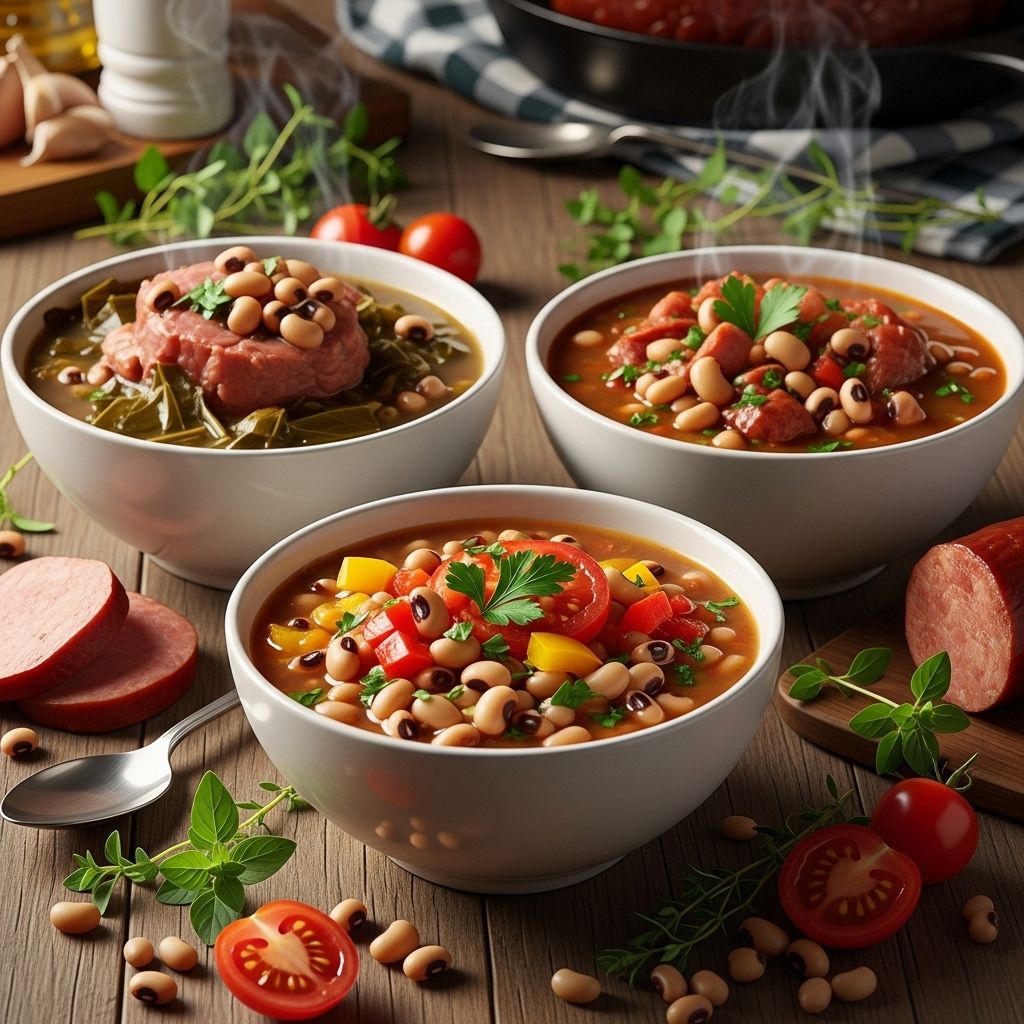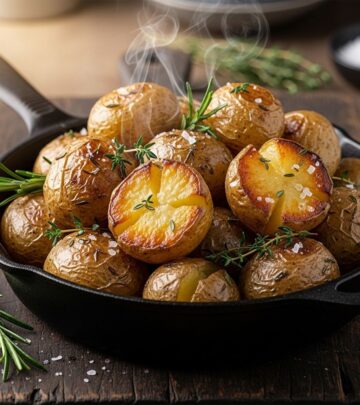Southern Black Eyed Peas Recipe: 3 Authentic Variations To Try
Discover the hearty goodness of a classic Southern dish perfect for New Year's or any day

Image: HearthJunction Design Team
Authentic Southern-Style Black-Eyed Peas: A Traditional Delight
Black-eyed peas have been a cornerstone of Southern cuisine for generations, offering not just sustenance but also carrying the weight of tradition and cultural significance. This humble legume, distinguished by its creamy texture and characteristic black ‘eye,’ transforms into a hearty, flavorful dish when prepared with the classic Southern approach of slow simmering with smoked meats and aromatic vegetables.
Whether you’re preparing this dish for good luck on New Year’s Day or seeking comfort food any time of the year, this Southern-Style Black-Eyed Peas recipe delivers authentic flavors that have stood the test of time. The combination of smoky ham hocks, crispy bacon, and tender peas creates a symphony of flavors that epitomizes Southern cooking at its finest.
The Cultural Significance of Black-Eyed Peas
Before diving into the recipe itself, it’s worth understanding why these humble legumes hold such importance in Southern culinary traditions. Black-eyed peas were brought to America during the Atlantic slave trade and became a staple crop in the South. Their ability to enrich soil with nitrogen made them valuable for crop rotation, while their nutritional profile provided essential protein for communities.
The tradition of eating black-eyed peas on New Year’s Day for good luck and prosperity dates back to the Civil War era. When Union troops swept through the South, they typically left the black-eyed peas untouched, considering them suitable only for animal feed. These overlooked legumes became a crucial food source for surviving Southerners, symbolizing resilience and good fortune.
Today, the tradition continues with many Southern families preparing this dish as part of their New Year’s celebration, often accompanied by collard greens (representing money) and cornbread (representing gold). However, the rich, comforting flavors of this dish make it worthy of enjoying year-round.
Ingredients for Traditional Southern-Style Black-Eyed Peas
The beauty of this classic recipe lies in its simplicity and the quality of its ingredients. Here’s what you’ll need to create an authentic pot of Southern black-eyed peas:
- 1 pound dried black-eyed peas
- 1 tablespoon vegetable oil
- 1 medium onion, chopped
- 5 cloves garlic, minced
- 1 pound smoked ham hocks
- 6 strips bacon, chopped
- 6 cups chicken broth
- 2 bay leaves
- 1 teaspoon dried thyme
- 1/2 teaspoon cayenne pepper (adjust to taste)
- 1 teaspoon salt (adjust to taste)
- 1/2 teaspoon freshly ground black pepper
- Hot sauce for serving (optional)
- Fresh chopped parsley for garnish (optional)
Preparing the Black-Eyed Peas
Proper preparation of the dried black-eyed peas is crucial for achieving the perfect texture and reducing cooking time. Follow these steps to prepare your peas:
Sorting and Cleaning
Begin by spreading the dried black-eyed peas on a clean, flat surface. Carefully sort through them, removing any small stones, damaged peas, or debris that might be mixed in. This step is essential as even commercially packaged dried legumes can occasionally contain foreign objects.
After sorting, place the peas in a colander and rinse thoroughly under cold running water, using your hands to stir them gently. This removes any dust or residue from the peas.
Soaking Methods
There are two primary methods for soaking black-eyed peas, and either will work well for this recipe:
Traditional Overnight Soak
Place the cleaned peas in a large bowl and cover with water by at least 2 inches. Allow them to soak overnight or for at least 8 hours at room temperature. This slow soaking method helps the peas hydrate gradually and evenly, reducing cooking time and promoting even texture.
Quick Soak Method
If you’re short on time, you can use the quick soak method. Place the cleaned peas in a large pot and cover with water by at least 2 inches. Bring to a boil and cook for 2 minutes. Remove from heat, cover the pot, and let the peas soak for 1 hour. This accelerated method works well when you’re pressed for time.
After soaking by either method, drain the peas thoroughly and rinse again with fresh water. They’re now ready to be incorporated into the recipe.
Cooking Instructions
The key to exceptional Southern-style black-eyed peas lies in the layering of flavors and slow, patient cooking. Follow these detailed steps for the best results:
Building the Flavor Base
- In a large Dutch oven or heavy-bottomed pot, heat the vegetable oil over medium heat until shimmering.
- Add the chopped bacon and cook until it begins to crisp and release its fat, about 5-7 minutes.
- Add the chopped onion to the bacon and continue cooking until the onion becomes translucent and softened, about 3-4 minutes.
- Add the minced garlic and cook for another 30 seconds until fragrant, being careful not to let it burn.
Adding the Peas and Aromatics
- Add the soaked and drained black-eyed peas to the pot, stirring to coat them with the flavorful fat.
- Place the ham hocks into the mixture, nestling them among the peas.
- Pour in the chicken broth, ensuring the peas and ham hocks are fully submerged. If necessary, add a bit more broth or water.
- Add the bay leaves, dried thyme, cayenne pepper, salt, and black pepper.
- Stir gently to combine all ingredients while being careful not to mash the peas.
Simmering Process
- Bring the mixture to a boil over medium-high heat, then reduce to a gentle simmer.
- Cover the pot partially with a lid, allowing some steam to escape while maintaining moisture.
- Simmer for approximately 1.5 to 2 hours, stirring occasionally to prevent sticking.
- Check the peas for tenderness after 1.5 hours. They should be tender but still hold their shape without becoming mushy.
- If the liquid reduces too much during cooking, add more broth or water in small amounts.
Finishing the Dish
- Once the peas are tender, remove the ham hocks from the pot and set aside until cool enough to handle.
- Remove and discard the skin, bones, and fatty portions of the ham hocks.
- Shred the remaining meat into bite-sized pieces and return it to the pot.
- Remove and discard the bay leaves.
- Taste and adjust the seasoning with additional salt, pepper, or cayenne as needed.
- Allow the peas to rest for 10-15 minutes before serving to allow the flavors to meld further.
Serving Suggestions and Accompaniments
Southern-Style Black-Eyed Peas are versatile and pair wonderfully with several traditional Southern sides. Here are some classic serving suggestions:
Traditional Accompaniments
- Cornbread: A slice of warm, buttery cornbread is the perfect companion for sopping up the flavorful broth from the black-eyed peas.
- Collard Greens: These nutritious greens complement the peas perfectly and are traditionally served alongside them, especially on New Year’s Day.
- Rice: Serving the peas over a bed of fluffy white rice creates a hearty, complete meal reminiscent of Hoppin’ John.
- Hot Sauce: Many Southerners enjoy adding a dash of hot sauce to brighten the flavors and add some heat.
- Raw Onion: Diced raw onion sprinkled on top adds a sharp, fresh contrast to the rich, slow-cooked peas.
Storage and Reheating
One of the beautiful aspects of Southern-Style Black-Eyed Peas is that they often taste even better the next day as the flavors continue to develop. Here’s how to properly store and reheat your leftovers:
Refrigeration
Allow the peas to cool completely before transferring to airtight containers. They will keep in the refrigerator for up to 4 days. The flavors will continue to meld and improve during storage.
Freezing
These black-eyed peas freeze exceptionally well. Portion them into freezer-safe containers, leaving about an inch of headspace to allow for expansion. They can be frozen for up to 3 months without significant loss of quality.
Reheating
To reheat refrigerated peas, place them in a saucepan over medium-low heat, adding a small amount of water or broth if they seem too thick. Heat gently, stirring occasionally, until warmed through.
For frozen peas, thaw overnight in the refrigerator before reheating, or reheat directly from frozen using a low heat and additional liquid as needed.
Variations and Adaptations
While the traditional recipe is delicious as is, there are several regional and personal variations you might consider:
Vegetarian Version
For a vegetarian adaptation, omit the ham hocks and bacon, and use vegetable broth instead of chicken broth. Add a tablespoon of smoked paprika and a teaspoon of liquid smoke to achieve a similar smoky flavor profile. Sautéed mushrooms can add umami depth as well.
Spicy Version
For those who enjoy heat, add a diced jalapeño or serrano pepper with the onions, or increase the cayenne pepper. Some cooks add a splash of apple cider vinegar-based hot sauce during cooking for tang and heat.
Creole Influence
For a Creole twist, add a diced bell pepper and a stalk of diced celery with the onions (creating the “holy trinity” of Creole cooking), along with a tablespoon of Creole seasoning and perhaps some sliced andouille sausage in place of or in addition to the bacon.
Frequently Asked Questions (FAQs)
Q: Do I have to soak the black-eyed peas before cooking?
A: While soaking is not absolutely necessary for black-eyed peas (unlike some harder beans), it is recommended as it reduces cooking time and helps the peas cook more evenly. If you’re short on time, you can use the quick soak method described earlier.
Q: Can I make this recipe in a slow cooker?
A: Yes! After sautéing the bacon, onions, and garlic on the stovetop, transfer everything to a slow cooker along with the remaining ingredients and cook on low for 6-8 hours or high for 3-4 hours, until the peas are tender.
Q: What if I can’t find ham hocks?
A: Smoked ham hocks can be substituted with smoked turkey necks, smoked turkey wings, or a ham bone. In a pinch, you could use bacon alone, though you’ll lose some of the distinctive flavor that ham hocks provide.
Q: Are black-eyed peas actually peas?
A: Despite their name, black-eyed peas are actually a type of bean from the legume family. They are also known as cowpeas or southern peas and are closely related to other beans.
Q: Why did my black-eyed peas turn mushy?
A: Overcooking is the most common cause of mushy peas. Check them frequently during cooking and remove from heat when they are tender but still hold their shape. Also, avoid vigorous boiling, which can break down the peas’ structure.
This Southern-Style Black-Eyed Peas recipe is more than just a meal; it’s a celebration of Southern culinary heritage and a delicious way to connect with traditions passed down through generations. Whether served as a good luck dish on New Year’s Day or enjoyed as comfort food throughout the year, these flavorful peas are sure to become a beloved addition to your recipe collection.
References
- https://www.allrecipes.com/recipe/282644/southern-style-black-eyed-peas/
- https://www.allrecipes.com/recipe/213029/new-year-black-eyed-peas/
- https://www.allrecipes.com/recipe/213015/daves-georgia-black-eyed-peas/
- https://www.allrecipes.com/recipe/221949/black-eyed-peas-with-pork-and-greens/
- https://www.allrecipes.com/recipe/16022/new-years-day-black-eyed-peas/
Read full bio of Shinta












